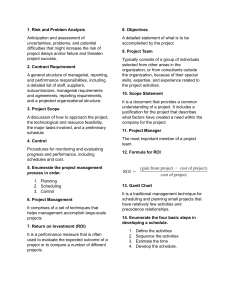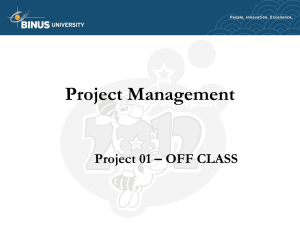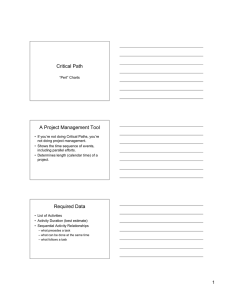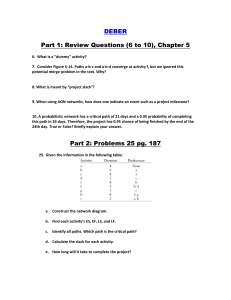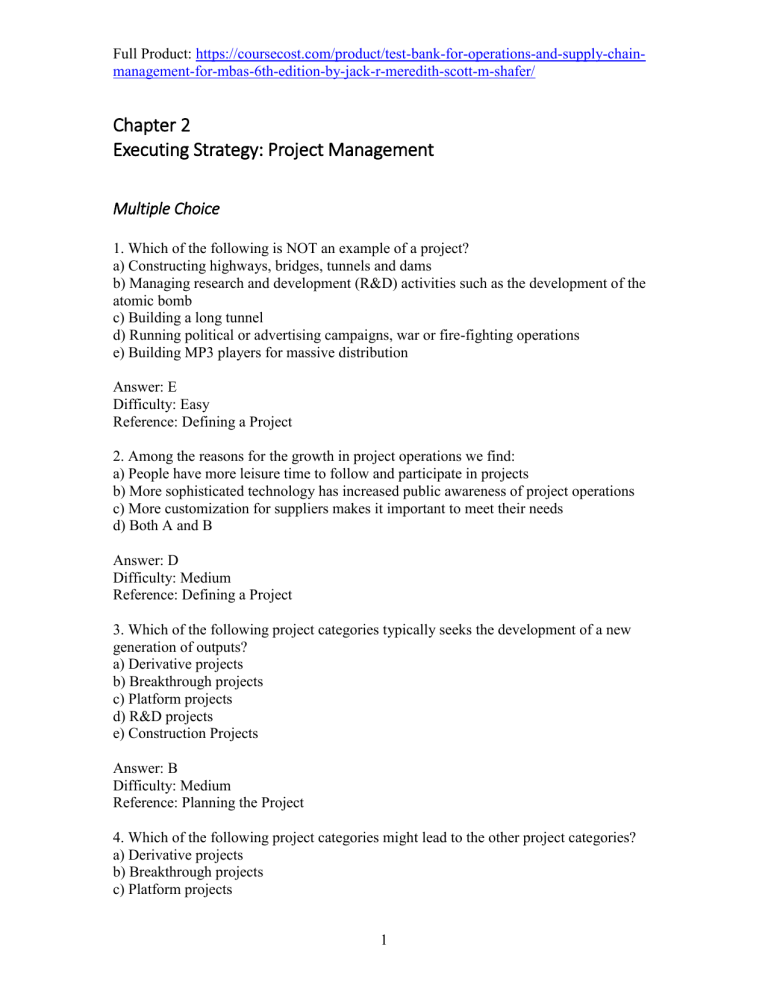
Full Product: https://coursecost.com/product/test-bank-for-operations-and-supply-chainmanagement-for-mbas-6th-edition-by-jack-r-meredith-scott-m-shafer/
Chapter 2
Executing Strategy: Project Management
Multiple Choice
1. Which of the following is NOT an example of a project?
a) Constructing highways, bridges, tunnels and dams
b) Managing research and development (R&D) activities such as the development of the
atomic bomb
c) Building a long tunnel
d) Running political or advertising campaigns, war or fire-fighting operations
e) Building MP3 players for massive distribution
Answer: E
Difficulty: Easy
Reference: Defining a Project
2. Among the reasons for the growth in project operations we find:
a) People have more leisure time to follow and participate in projects
b) More sophisticated technology has increased public awareness of project operations
c) More customization for suppliers makes it important to meet their needs
d) Both A and B
Answer: D
Difficulty: Medium
Reference: Defining a Project
3. Which of the following project categories typically seeks the development of a new
generation of outputs?
a) Derivative projects
b) Breakthrough projects
c) Platform projects
d) R&D projects
e) Construction Projects
Answer: B
Difficulty: Medium
Reference: Planning the Project
4. Which of the following project categories might lead to the other project categories?
a) Derivative projects
b) Breakthrough projects
c) Platform projects
1
Full Product: https://coursecost.com/product/test-bank-for-operations-and-supply-chainmanagement-for-mbas-6th-edition-by-jack-r-meredith-scott-m-shafer/
d) R&D projects
e) None of the above
Answer: D
Difficulty: Medium
Reference: Planning the Project
5. Project charters should contain some level of information regarding which of the
following elements:
a) Business case, goals, or scope
b) Overview, general approach, schedules or milestones
c) Work breakdown structure and path dependencies
d) Both A and B
e) None of the above
Answer: D
Difficulty: Medium
Reference: Planning the Project
6. Which of the following terms provides the basis for the project schedule, often
formatted as a project Gantt chart?
a) Critical path
b) Slack
c) Float
d) Earned value
e) Work breakdown structure
Answer: E
Difficulty: Medium
Reference: Planning the Project
7. The set of all project activities graphically interrelated through precedence
relationships is known as a/an:
a) Activity
b) Event
c) Network
d) d) Path
e) Gantt chart
Answer: C
Difficulty: Medium
Reference: Scheduling the Project
8. Any path that if delayed will delay the completion of the entire project is known as a:
a) Significant path
b) Critical path
2
Full Product: https://coursecost.com/product/test-bank-for-operations-and-supply-chainmanagement-for-mbas-6th-edition-by-jack-r-meredith-scott-m-shafer/
c) Central path
d) Network path
e) Troublesome path
Answer: B
Difficulty: Easy
Reference: Scheduling the Project
9. All of the following are important outputs of project scheduling, except:
a) Identification of slack times for all activities and paths
b) Earliest and latest time each activity can be completed
c) Networks and paths
d) Identification of critical activities
Answer: C
Difficulty: Easy
Reference: Scheduling the Project
10. The amount of flexibility the project manager has in terms of starting and completing
an activity is referred to as its:
a) Slack
b) Float
c) Flex
d) Give
e) Both A and B
Answer: E
Difficulty: Easy
Reference: Scheduling the Project
11. Duration of critical path – path duration = __________?
a) Latest finish time
b) Critical time
c) Path slack
d) Latest start time
e) Project slack
Answer: C
Difficulty: Medium
Reference: Scheduling the Project
12. The amount of time a project manager estimates it will take to complete the activity
under ideal conditions is known as:
a) Pessimistic time
b) Optimistic time
c) Likeliest time
3
Full Product: https://coursecost.com/product/test-bank-for-operations-and-supply-chainmanagement-for-mbas-6th-edition-by-jack-r-meredith-scott-m-shafer/
d) Utopian time
e) Slack time
Answer: B
Difficulty: Easy
Reference: Scheduling the Project
13. Which of the following statement(s) concerning probabilities of completion is/are
incorrect?
a) Using the variance of each activity, we can compute the likelihood of completing the
project in a given time period.
b) The probability of completing a path is found by calculating the standard normal
deviate of the desired completion time less the expected completion time.
c) The distribution of a path’s completion time will be approximately normally
distributed if the path has a large number of activities on it.
d) The individual activity completion times must be normally distributed
e) All of the above are incorrect
Answer: D
Difficulty: Hard
Reference: Scheduling the Project
14. When workers receive approval for a task based on inflated time estimate, they may
perceive that they now have plenty of time to complete the task and therefore delay
starting the task. What has this concept been called?
a) Senioritis
b) Inflation syndrome
c) Time-shift
d) Goldratt delay
e) Student syndrome
Answer: E
Difficulty: Easy
Reference: Scheduling the Project
15. According to Goldratt, to complete a project on time, the highest priority should be
given to the:
a) Critical buffer
b) Feeding chain
c) Project buffer
d) Critical chain
e) Slack activities
Answer: D
Difficulty: Hard
Reference: Scheduling the Project
4
Full Product: https://coursecost.com/product/test-bank-for-operations-and-supply-chainmanagement-for-mbas-6th-edition-by-jack-r-meredith-scott-m-shafer/
True/False
16. An optimal procedure for organizations to accept projects is to specify a return on
investment (ROI) and fund only projects that meet this criterion.
Answer: False
Difficulty: Easy
Reference: Planning the Project
17. The project life cycle typically has a stretched-s or an exponential form.
Answer: True
Difficulty: Easy
Reference: Planning the Project
18. Projects should be evaluated against standards and by methods established at their
completion, including procedures for monitoring, collecting, storing, and evaluating the
history of the project.
Answer: True
Difficulty: Hard
Reference: Planning the Project
19. An event is a series of connected activities from the start to the finish of the project.
Answer: False
Difficulty: Easy
Reference: Scheduling the Project
20. The amount of flexibility the project manager has in terms of starting and completing
an activity is referred to as its slack.
Answer: True
Difficulty: Easy
Reference: Scheduling the Project
21. The optimistic time is the amount of time the project will take under the worst-case
scenario.
Answer: False
Difficulty: Easy
Reference: Scheduling the Project
22. Using CPM, when activity times are not known with certainty, we still can determine
how long it will actually take to complete the project.
5
Full Product: https://coursecost.com/product/test-bank-for-operations-and-supply-chainmanagement-for-mbas-6th-edition-by-jack-r-meredith-scott-m-shafer/
Answer: False
Difficulty: Easy
Reference: Scheduling the Project
23. Three phenomena that tend to bias the expected completion time of projects are
inflated time estimates, activity time variability with path interdependencies, and resource
dependence.
Answer: True
Difficulty: Medium
Reference: Scheduling the Project
24. The amount of safety time needed to protect a particular path in a project is less than
the sum of the safety times required to protect the individual activities making up the
path.
Answer: True
Difficulty: Easy
Reference: Scheduling the Project
25. The objective of feeding buffers is to ensure that non-critical chains are completed so
that they do not delay tasks on the critical chain.
Answer: True
Difficulty: Medium
Reference: Scheduling the Project
26. Favorable variances do not require corrective action or further investigation; only
unfavorable variances in performance.
Answer: True
Difficulty: Medium
Reference: Controlling the Project: Earned Value
Fill in the Blank
27. Both PERT and CPM are based on variations of the __________ chart?
Answer: Gantt
Difficulty: Hard
Reference: Planning the Process
28. The amount of _____ _____ needed to protect a particular path in a project is less
than the sum of the _____ _____ required to protect the individual activities making up
the path.
6
Full Product: https://coursecost.com/product/test-bank-for-operations-and-supply-chainmanagement-for-mbas-6th-edition-by-jack-r-meredith-scott-m-shafer/
Answer: safety time, safety times
Difficulty: Medium
Reference: Scheduling the Project
29. When a project cost, schedule, or time variance is significant, the project manager
must identify (or at least try to do so) an __________ cause for the variance so that the
proper remedy can be used to keep it from recurring.
Answer: assignable
Difficulty: Medium
Reference: Controlling the Project: Earned Value
Short Answer
30. Give an example of Inflated Activity Time Estimates.
Answer: Answers will vary. One possible answer is as follows. An employee to a retail
store might purposely inflate the time it takes him to recover the store's inventory
organization to his managers to buy extra time to complete his job. He will also not report
when his actual completion time for fear of management shorting the time span. This
would affect the worker to work more quickly and harder to meet completion time.
Difficulty: Easy
Reference: Inflated Activity Time Estimates
31. Give an example of Activity Time Variability with Path Interdependencies.
Answer: Answers will vary. One possible answer is as follows. A gun smith shop, which
makes guns upon request, will only start production when a gun is ordered. Assuming all
parts is interchangeable. Thus when a gun is ordered then every worker at the shop goes
in to action. The time it takes the barrel maker is around three weeks. It takes the stock
and handle maker around a month and a half to complete the stock and handles. It takes
the bolt maker three months to complete the bolt. Therefore, when the gun shop is giving
a customer an estimate on the length of time it takes to complete a gun the answer given
will be three months because it takes the bolt maker the longest time out of the
production.
Difficulty: Easy
Reference: Activity Time Variability with Path Interdependencies
32. Give an example of Resource Dependence.
Answer: Answers will vary. One possible answer is as follows. A high-end sword shop
makes custom swords for well-paying customers. When a sword is ordered the shop goes
into action. The sword blade and tang must be forged first because with each hammer
stroke the blacksmith is changing the dimensions of the sword meaning two of the same
swords are going to be slightly different. When forging is done then the handle, cross-
7
Full Product: https://coursecost.com/product/test-bank-for-operations-and-supply-chainmanagement-for-mbas-6th-edition-by-jack-r-meredith-scott-m-shafer/
guard, and pommel are fitted custom to that particular sword. Then the scabbard is made
for the sword which depended on the shape of the cross-guard and the dimensions of the
blade for a perfect fit. The estimated time to completion is the sum of all the activities,
which is approximately five months.
Difficulty: Easy
Reference: Resource Dependence
33. What three outcomes must a project manager determine when scheduling a project
with uncertain activity times and the significance of each?
Answer: The project manage must develop three estimates, optimistic time, pessimistic
time, and most likely time. The optimistic time is the expected time to complete under
ideal conditions and would only take less time than this one percent of the time. The
pessimist time is the time the project would take under the worst-case scenario; again
only a one percent chance it would take longer than this time. The most likely time is the
project manager’s best estimate to how long the project will actually take.
Difficulty: Easy
Reference: Project Scheduling with Uncertain Activity Times
34. Briefly describe the importance of a Project charter.
Answer: A project charter describes the purpose of the project as well objectives the
project is expected to meet and what determines the project a success. The charter also
contains a detailed description of requirements, and resource or budget restrictions that
may apply. A project charter thoroughly lists all parties that will be involved directly and
indirectly with project team processes. The charter also outlines major scheduling dates
and milestones, as well as a contingency plan if problems arise. Lastly the charter
contains some form of predetermined evaluation method against established standards.
Difficulty: Easy
Reference: Project Plans
35. How does benchmarking improve operations? And give a relevant example.
Answer: Benchmarking is evaluating your operations to another companies/persons
operations to see where it is they are potentially better at, and where you can implement
their actions to improve your own. Benchmarking helps one get better plans to correct
their problems/issues, helps save money by looking at another company to improve, and
lowers time needed to come up with a new idea to a problem when perhaps another
company has faced that issue too, and came up with a solution. An example would be the
VHA story found on page 35, how they benchmarked other healthcare providers to
improve their claim processing abilities.
Difficulty: Easy
Reference: Introduction
36. How are projects not like other typical or routine processes?
8
Full Product: https://coursecost.com/product/test-bank-for-operations-and-supply-chainmanagement-for-mbas-6th-edition-by-jack-r-meredith-scott-m-shafer/
Answer: A project is more unique in nature than a typical or routine process. There is
often very little “sets of rules/procedures” to follow to correctly navigate to the correct
answer to unique projects. A typical routine or process such as building a Chevrolet
Malibu is fairly straightforward with very little uniqueness, and has clear-cut guidelines
for making it. Whereas something like a wedding is a project that is unique in nature
because no weddings are exactly alike, and each user has different desires and needs to be
met. Projects take on unique aspects which makes them different from a routine process.
Difficulty: Easy
Reference: Defining a Project
37. Why is a project portfolio a better approach to a project than the ROI approach?
Answer: Because a project portfolio is more diversified and looks at more aspects than
just the projects rate of return (ROI). Projects that use a portfolio are more successful,
cover a broader range of concerns, and are completed in a more timely manner and come
in on budget. Projects too concerned with ROI end up with more incomplete projects that
need to be either completed after the due date, or become an ongoing problem.
Difficulty: Moderate
Reference: The Project Portfolio
38. What is the product life cycle (PLC)?
Answer: The product life cycle is the different phases of a products life. The product life
cycle includes the initiation, implementation, and termination. These stages vary in time
and length according to what the project is, for instance software has a short life cycle
because technology is changing basically daily, where as a particular model of a car
would have a longer life cycle because car models are typically produced for several
years before a new updated model of that car is introduced. Project initiation is usually a
slow process because that is when everything is getting organized. The implementation is
where a lot of the product progress in the market happens, and termination is where
everything slows down.
Difficulty: Easy
Reference: The Project Life Cycle
39. Why is being able to predict activity times crucial in order to meet the demands of
your customer?
Answer: Timing is a very important factor when dealing with project management. If a
customer comes to you with a project that needs to be done in six months, necessary
actions and planning are done in order to make sure you make that deadline. As a project
manager you need to know when you have a critical path, critical activity or slack in
regards to the previous two paths. If you do not know if you have any of the three things
mentioned above, it is very difficult to plan when you will have the project completed.
Difficulty: Moderate
Reference: Calculating Activity Durations
9
Full Product: https://coursecost.com/product/test-bank-for-operations-and-supply-chainmanagement-for-mbas-6th-edition-by-jack-r-meredith-scott-m-shafer/
40. Why might it be useful to simulate project completion times?
Answer: Simulating project times using a program like Crystal Ball, helps you set
deadlines and have the ability to give the customer the most accurate time frame that can
be made. By making a projected deadline, the project manager is able to allocate workers
to different tasks on who would fit best for the length of time given. Simulating
completion times might also prevent future conflicts from arising such as resource
overlap. If the project manager is able to predict when certain tasks will be completed, he
will be able to schedule when each resource will be used and where they will need to be.
Difficulty: Moderate
Reference: Simulating Project Completion Times
41. Compare and contrast PERT and CPM.
Answer: The CPM method provides predictable or times for each activity whereas the
PERT method has random activity time. PERT activities are shown through the arrow
lines between the nodes and CPM are represented as the nodes. PERT gives multiple
estimates of times for each activity that allows for variation of activity times.
Difficulty: Easy
Reference: Project Completion and Critical Paths
42. Provide an example of how a project manager can use slack time.
Answer: Answers will vary. One possible answer follows. A project manager can see
how much slack the entire project has and compare it to the critical path to get the slack
time. The project manager can evaluate this time and find out how to decrease the activity
time and where they should invest money to generate a smaller slack time. If the project
manager wants to finish a project in 10 days as opposed to 15 days they can look at the
activities that has slack and figure out if they can reduce the activity time by five days in
a cost effective way.
Difficulty: Moderate
Reference: Slack Time
Essay
43. Explain the importance of slack time and how it can impact the critical path.
Answer: Slack time is the amount of time a project activity may be delayed until where
further delay would delay the entire project. Slack time allows a project manager to use
resources between activities to help expedite the project. For example projects with slack
time can have resources shifted to an activity along the critical path to help facilitate
completion, which could result in the project finishing early.
Difficulty: Moderate
Reference: Slack time
44. Describe the four qualities are sought after in a project manager.
10
Full Product: https://coursecost.com/product/test-bank-for-operations-and-supply-chainmanagement-for-mbas-6th-edition-by-jack-r-meredith-scott-m-shafer/
Answer: Project managers must be credible in both a technical and administrative
capacity to handle the range of important stakeholders. PMs must also be sensitive to the
politics and personalities they will be involved with. Projects often have inner conflict as
well as conflict with higher administration and outsiders and must detect these conflicts
and defuse them before it turns into a crisis. A PM must also have strong leadership skills
and competencies that correspond with the appropriate project. Lastly PMs must able to
handle stress. Projects are often formed because the organization isn’t able to handle the
special task with normal operations. Projects typically have tight schedules and difficult
goals that will increase stress level.
Difficulty: Moderate
Reference: Organizing the Project Team
45. Describe the two types of project organizational structure were discussed and the
advantages of both.
Answer: The first organizational structure described was functionally structured. In a
functionally structures organization the organization is broken up into specific
departments and project teams are housed and report to the division that has a major
interest in the project. If a broad project is chosen than members from each department
are selected to from the project team and then report to a division head or vice president.
The primary advantage of functionally organized is the depth of knowledge one particular
department would have regarding their own project. The second structure is projectized
organizations. In a projectized structure the teams are broken into particular contracts the
firm is working on, while the administrative support groups, like HR and finance, are
staff units that report higher up in the organization but provide support to all the different
teams. If there are particularly large and long running contracts they may have their own
dedicated staff. An advantage of a projectized organization is the entire team is dedicated
to a common goal that reports to one project manager rather than a chain of supervisors.
Difficulty: Moderate
Reference: Projects in the Organizational Structure
46. Many projects require different emphases during their life cycle. For example,
technical performance may be crucial at the beginning, cost overruns in the middle, and
on-time completion at the end. Given the project of running a political campaign, what
would be there top three emphases starting from the beginning to end?
Answer: Answers will vary. One possible answer is as follows. There is a lot of work that
has to come into play when running a political campaign. However, the top three
emphases on doing this project would be obtaining the funds to run a successful
campaign at the beginning. In the middle of the project is when the technology comes
into play- creating ads and commercials, creating websites, etc. Lastly, to run a successful
political campaign, the candidate, after having the funds and ads, must schedule meetings
with the press and any political debates necessary.
Difficulty: Moderate
Reference: Defining a Project
11
Full Product: https://coursecost.com/product/test-bank-for-operations-and-supply-chainmanagement-for-mbas-6th-edition-by-jack-r-meredith-scott-m-shafer/
47. Give an example of a derivative project and explain why your reasoning.
Answer: Answers will vary. One possible answer is as follows. A derivative project is
defined as a project that seeks to make incremental improvements in the output and/or
process. They seek to reduce the output’s cost or make minor product line extensions. An
example of this would be Apple’s innovation in annually changing the shape and design
of their iPhones. By slimming down the size of their iPhones, they are reducing the
output’s cost. Sometimes, when Apple adds a feature to the iPhone, this also falls into the
category of a derivative project because they are making minor production line
extensions.
Difficulty: Moderate
Reference: The Project Portfolio
48. Give an example of a project with the exponential life cycle and describe why this is a
good example.
Answer: A good example of the exponential life cycle would be anything that requires
constant work to result in one final piece. One example of this could be a student at
Kennesaw State University working towards their Bachelor’s degree. A lot of work is put
in to getting this degree- taking classes, making good grades, staying up on school
payments, and results in an end result, the degree. Another example of this could be an
advertisement. The company must initially contact an ad agency, and from there the ad
agency gathers information such as the target market, information about the product and
competition, etc. Eventually, the ad agency will come back to the company with one
completed piece of an ad. These two examples are great when it comes to defining the
exponential life cycle of a project.
Difficulty: Moderate
Reference: The Project Life Cycle
12


